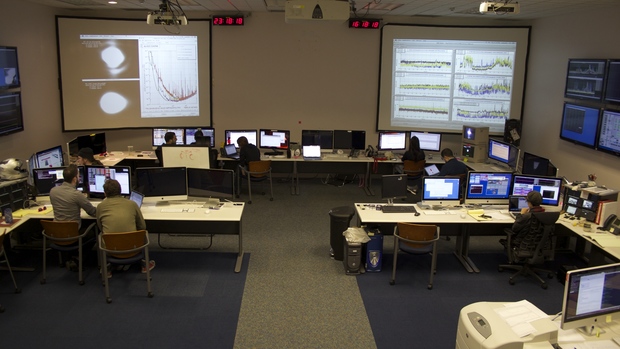
LIGO Hanford Observatory control room. Credit: Caltech/MIT/LIGO Lab.
LIGO-Virgo-KAGRA Webinar to Discuss New Results on the Gravitational-wave Background
News Release • February 2, 2021
On Thursday 4 February, at 10:00 Eastern US (other time zones below), the LVK will host an online webinar entitled “Constraining astrophysical and cosmological gravitational-wave backgrounds with Advanced LIGO and Virgo's third observing run.” We will present results from our recent papers: arxiv.org/abs/2101.12248 and arxiv.org/abs/2101.12130. The webinar is open to all.
Register for the webinar.
LIGO-Virgo-KAGRA Webinar
Thu, 4 Feb at 10:00 Eastern Time (US and Canada)
Thu, 4 Feb at 07:00 (US PST/Los Angeles)
Thu, 4 Feb at 09:00 (US CST/Chicago)
Thu, 4 Feb at 16:00 (CET/Pisa, Italy)
Thu, 4 Feb at 20:30 (IST/Pune, India)
Fri, 5 Feb at 00:00 (JST/Tokyo)
Fri, 5 Feb at 02:00 (AEDT/Sydney)
A recording will be posted after the seminar for those who cannot attend the live event.
Update: View the webinar:
Listening for Signals from the Distant Universe
Constraining astrophysical and cosmological gravitational-wave backgrounds with Advanced LIGO and Virgo's third observing run
Abstract: Advanced LIGO and Virgo have opened a new window to the Universe with the discoveries of individual compact binary mergers. The gravitational wave signals we have identified so far are only the tip of the iceberg; the very loudest signals that we can detect at our current sensitivity. Compact binary mergers from larger distances than we can detect, cusps and kinks in a web of cosmic strings created in the early Universe, the echo of the inflationary period thought to have happened a fraction of a second after the Big Bang -- these are all signals that can contribute to a gravitational-wave background. Using the most recent data from the third observing run, we searched for the presence of the gravitational-wave background. While we did not make a detection, we placed the best-yet upper limits on the strength of the background. We also showed that correlated instrumental noise -- which can negatively impact our search if present -- was well below the level of the sensitivity. We studied the implications of these results for two of the most promising sources. First, we considered the background made of all the compact binary mergers too far or too quiet for us to detect individually, and found that in future runs with more sensitivity we may be able to detect that background. Second, we looked at the implications for models of cosmic strings. We use information from state-of-the-art modelling of these fascinating objects, including for the first time models for the collision of two kinks. We placed upper limits both by performing a burst search for individual cosmic string events, and by looking at the gravitational-wave background, and we place the strongest constraints on the string tension in the literature. We also compared the upper limits to those placed by other measurements. In this webinar, we will discuss these results in detail and discuss the next steps for this approach to exploring the gravitational-wave Universe.




